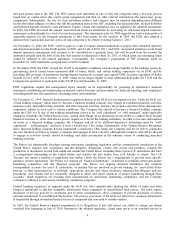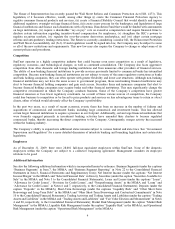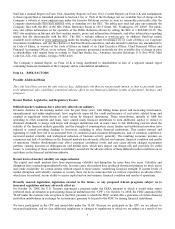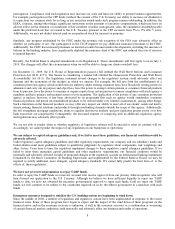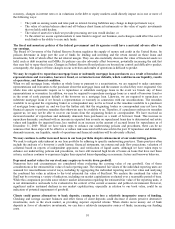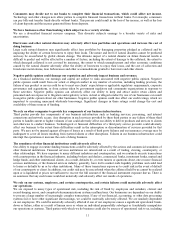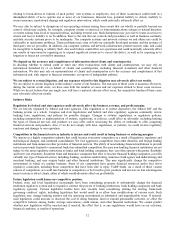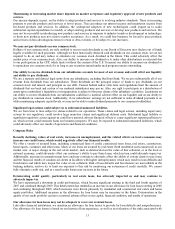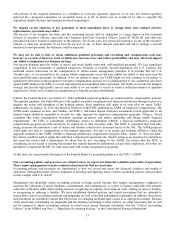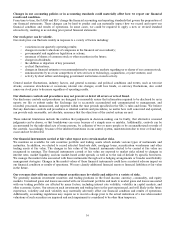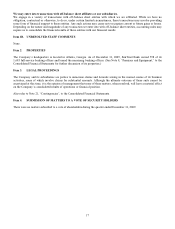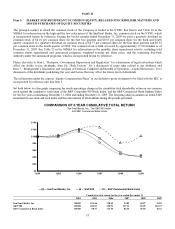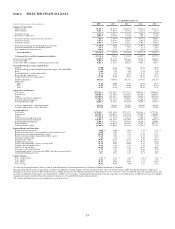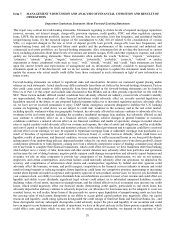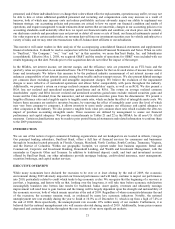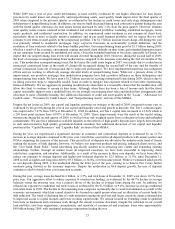SunTrust 2009 Annual Report Download - page 29
Download and view the complete annual report
Please find page 29 of the 2009 SunTrust annual report below. You can navigate through the pages in the report by either clicking on the pages listed below, or by using the keyword search tool below to find specific information within the annual report.Maintaining or increasing market share depends on market acceptance and regulatory approval of new products and
services.
Our success depends, in part, on the ability to adapt products and services to evolving industry standards. There is increasing
pressure to provide products and services at lower prices. This can reduce net interest income and noninterest income from
fee-based products and services. In addition, the widespread adoption of new technologies could require us to make
substantial capital expenditures to modify or adapt existing products and services or develop new products and services. We
may not be successful in introducing new products and services in response to industry trends or development in technology,
or those new products may not achieve market acceptance. As a result, we could lose business, be forced to price products
and services on less advantageous terms to retain or attract clients, or be subject to cost increases.
We may not pay dividends on your common stock.
Holders of our common stock are only entitled to receive such dividends as our Board of Directors may declare out of funds
legally available for such payments. Although we have historically declared cash dividends on our common stock, we are not
required to do so and may reduce or eliminate our common stock dividend in the future. This could adversely affect the
market price of our common stock. Also, our ability to increase our dividend or to make other distributions is restricted due
to our participation in the CPP, which limits (without the consent of the U.S. Treasury) our ability to increase our dividend or
to repurchase our common stock for so long as any securities issued under such program remain outstanding.
Our ability to receive dividends from our subsidiaries accounts for most of our revenue and could affect our liquidity
and ability to pay dividends.
We are a separate and distinct legal entity from our subsidiaries, including SunTrust Bank. We receive substantially all of our
revenue from dividends from our subsidiaries. These dividends are the principal source of funds to pay dividends on our
common stock and interest and principal on our debt. Various federal and/or state laws and regulations limit the amount of
dividends that our bank and certain of our nonbank subsidiaries may pay us. Also, our right to participate in a distribution of
assets upon a subsidiary’s liquidation or reorganization is subject to the prior claims of the subsidiary’s creditors. Limitations on
our ability to receive dividends from our subsidiaries could have a material adverse effect on our liquidity and on our ability to
pay dividends on common stock. Additionally, if our subsidiaries’ earnings are not sufficient to make dividend payments to us
while maintaining adequate capital levels, we may not be able to make dividend payments to our common stockholders.
Significant legal actions could subject us to substantial uninsured liabilities.
We are from time to time subject to claims related to our operations. These claims and legal actions, including supervisory
actions by our regulators, could involve large monetary claims and significant defense costs. Substantial legal liability or
significant regulatory action against us could have material adverse financial effects or cause significant reputational harm to
us, which in turn could seriously harm our business prospects. We may be exposed to substantial uninsured liabilities, which
could adversely affect our results of operations and financial condition.
Company Risks
Recently declining values of real estate, increases in unemployment, and the related effects on local economies may
increase our credit losses, which would negatively affect our financial results.
We offer a variety of secured loans, including commercial lines of credit, commercial term loans, real estate, construction,
home equity, consumer and other loans. Many of our loans are secured by real estate (both residential and commercial) in our
market area. A major change in the real estate market, such as deterioration in the value of this collateral, or in the local or
national economy, could adversely affect our customer’s ability to pay these loans, which in turn could adversely impact us.
Additionally, increases in unemployment have and may continue to adversely affect the ability of certain clients to pay loans
and the financial results of commercial clients in localities with higher unemployment, which may result in loan defaults and
foreclosures and which may impair the value of our collateral. Risk of loan defaults and foreclosures are unavoidable in the
banking industry, and we try to limit our exposure to this risk by monitoring our extensions of credit carefully. We cannot
fully eliminate credit risk, and as a result credit losses may increase in the future.
Deteriorating credit quality, particularly in real estate loans, has adversely impacted us and may continue to
adversely impact us.
We have experienced a downturn in credit performance, which became significant starting in the third and fourth quarters of
2007 and continued through 2009. This deterioration has resulted in an increase in our allowance for loan losses starting in 2008
and continuing throughout 2009, which increases were driven primarily by residential and commercial real estate and home
equity portfolios. Additional increases in the allowance for loan losses may be necessary in the future. Deterioration in the
quality of our credit portfolio can have a material adverse effect on our capital, financial condition, and results of operations.
Our allowance for loan losses may not be adequate to cover our eventual losses.
Like other financial institutions, we maintain an allowance for loan losses to provide for loan defaults and nonperformance.
Our allowance for loan losses is based on our historical loss experience, as well as an evaluation of the risks associated with
13



